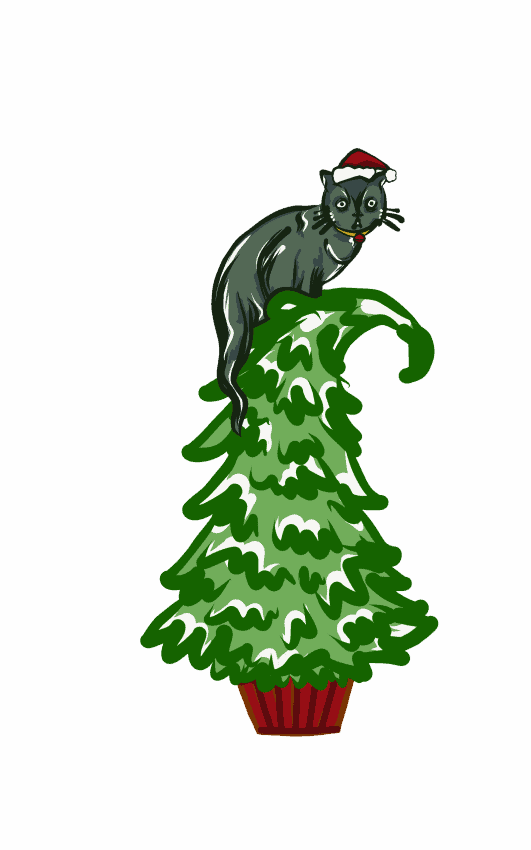
It’s the most wonderful time of the year and the air is heavy with festive tidings of joy. Sleigh bells ring, are ya listenin’? While this Christian holiday celebrates the birth of Jesus Christ, the origins of the celebration are rooted in pagan festivals and traditions.
In the ancient world, Christianity was a small, insignificant sect of people scattered across the globe. The Roman Empire, the once brutal pagan giant, adopted the religious movement over several decades. In 313 CE, the practice of Christianity was legalized in Rome. By 380 CE it was adopted as the official religion of the Empire.
The winter solstice, the longest night of the year, was a time of celebration in many pagan cultures across the world and in Rome they celebrated Saturnalia, a festival for the God Saturn. In the pagan empire, Saturnalia fell between Dec. 17 and 23, and when the Romans converted to Christianity, their winter celebration was altered as well.
Saturnalia was a time of gift giving and singing, and Romans decorated their houses with greenery and red berries. These traditions, deeply rooted in the empire’s culture, continued on with its adoption of Christanity, becoming traditions of modern day Christmas.
Of course we know that Christanity didn’t stop in Rome but spread across the world. Christian missionaries found that when pagan communities converted to the religion they often continued with their pagan traditions and festivals. Many of these were absorbed as Christian tradition over hundreds of years.
Oh Christmas Tree? European pagans and Romans can be credited for their use.
Deck the halls with boughs of holly? Holly was the sacred plant of the God Saturn and was used in his festival to honour him.
Saw Mommy kissing Santa Claus under the mistletoe last night? The plant was sacred to the Norse and Celtic pagans and have origins with the druids of Europe. They were symbols of peace and joy.
Speaking of Santa Claus, jolly old St. Nicholas can’t possibly be pagan right? St. Nicholas was a bishop from what is now modern day Turkey, who had a reputation for gift-giving and was adopted as “father christmas” or “Pere Noel” after the 16th century. He is a man with many names, leaving gifts in stockings and shoes for children to find.
The image of Santa Claus that we are familiar with today is the product of the “God of Marketing”, and was the creation of Coca-Cola for their 1930 advertisement campaigns. But Santa Claus also has some deeply pagan origins. Odin, another man of many names, is a well-known god in Germanic paganism, which spanned across Europe and Scandinavia.
One of Odin’s names is Yule Father, and during the winter solstice children would place their boots near the chimneys and fire holes and wait for Odin to come with gifts. The boots would be filled with straw for Odin’s eight-legged horse, Slepnir, whom Odin rode during the night of the Wild Hunt — Dec. 21.
Christmas has a rich folklore in places like Italy, where the old woman Befan, also known as the Christmas Witch, delivers gifts to children. In Austrian and Barvarian lore, Frau Perchta would visit houses, leaving silver coins for those who had behaved and worked hard over the year. If you were guilty of slacking on your duties, Frau Perchta would cut you open, remove your innards and replace them with straw and stones.
In Finland, Joulupukki, also known as the Yule Goat, would visit houses — demanding gifts and leftovers. Today, he drops off presents after politely ringing the doorbell.
Iceland is a country that was settled by Vikings in 874 AD and by 1000 AD, Christianity was adopted by the Icelandic settlers as the official religion. But Iceland’s Christmas folklore remains rich and dark. The major players include Gryla, a giantess who eats misbehaving children, and The Yule cat, a large black cat who stalks Iceland on Christmas, looking to eat children who haven’t received new clothes. So thank your aunt for that ugly sweater you get this Christmas.
While Christmas may be a Christian holiday, it is one that is dressed up in the pagan clothes of the cultures it absorbed throughout the millennia.
—
Erin Matthews/ Opinions Editor
Graphic: Ana Cristina Camacho/ News Editor